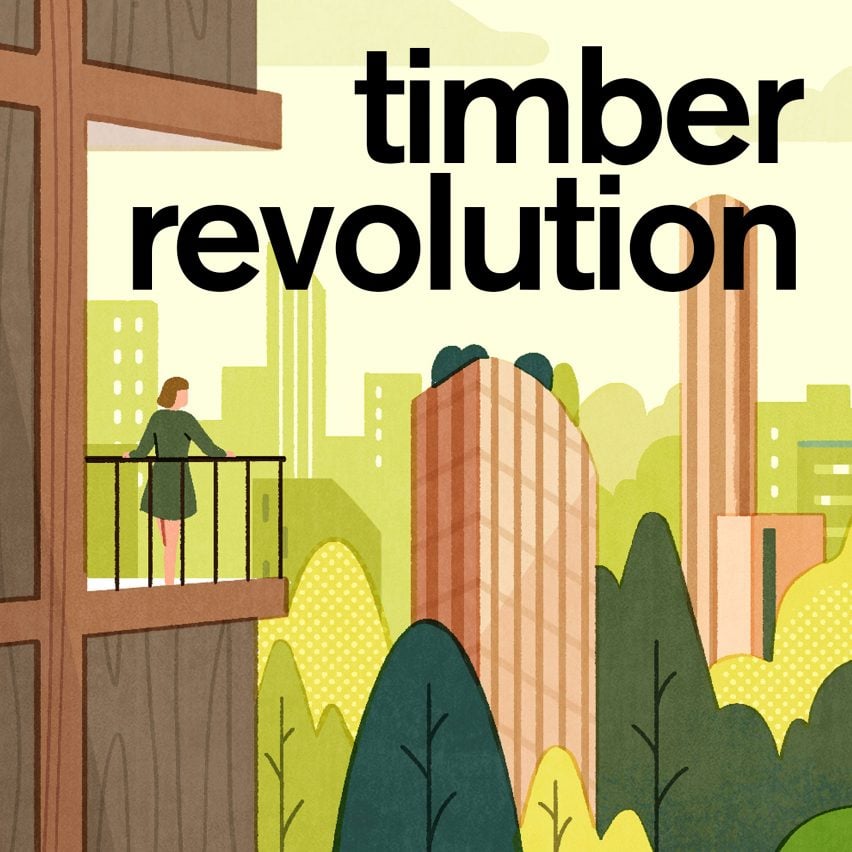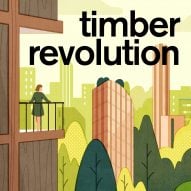A Timber Revolution requires us to focus on reducing mass-timber structures’ raw-material use instead of trying to design the tallest possible wooden building, writes Maximilian Pramreiter.
The renaissance of wood as a building material continues and has major potential to support climate-friendly construction – but it must be used efficiently.
From the second half of the 19th century, almost every product in our lives changed from being made out of a bio-based material to a highly engineered fossil-based alternative. The materials used to construct our buildings changed from natural materials like wood, stone and clay – which were considered antiquated and inferior – to man-made materials like steel, cement and glass.
The renaissance of one of the oldest building materials – wood – has already begun
The combination of steel frames, formwork concrete and glass facades led to the emergence of skyscrapers and marks the beginning of the age of steel at the end of the 19th century. The ensuing race for the design of the world’s highest building reached its temporary climax in 2010 with the completion of the Burj Khalifa at a record height of 828 metres. Today, every well-known city has at least one famous skyscraper in its skyline and concrete, as well as steel, dominates the architectural landscape regardless of the size of the project or its structural necessity.
The debate about how to combat climate change is now putting increasing pressure on the built environment, which currently generates roughly 40 per cent of the world’s annual greenhouse gas emissions. According to the International Energy Agency, around a third of these building-related emissions are emitted during construction, also known as embodied carbon.
Much of the current discussion on climate protection therefore focuses on how to replace modern construction materials with climate-friendly alternatives. Against this background, the renaissance of one of the oldest building materials – wood – has already begun.
Wood has the ability not only to substitute carbon-intensive materials, but also store carbon in the built environment. This makes it the perfect climate-friendly building material and it is without question that wood will play a key role in transforming the global building sector into a carbon sink.
Quite naturally, a similar race to construct the highest timber building has started. Architecture publications are full of the newest, loftiest wooden skyscrapers, such as Ascent Tower in the USA, which is currently the tallest timber structure in the world at 87 metres, followed by the Mjøstårnet Building in Norway at 85 metres, the HoHo Tower in Austria at 84 metres and the Sara Kulturhus Centre in Sweden at 75 metres.
These innovative heights are achieved using a combination of concrete and engineered wood products, primarily cross laminated timber (CLT) and glued laminated timber (GLT). CLT especially has experienced rapid market growth, with production capacities doubling within a couple of years.
Both CLT and GLT have a distinct disadvantage: their raw-material footprint
Among other things, this success story is mainly driven by two factors. Firstly, engineered timber offers a high degree of homogenisation of the natural material wood, which simplifies structural design. Secondly, it provides the possibility to pre-fabricate complete wall and floor elements before delivery to the construction site, shortening overall construction times.
Nevertheless, both CLT and GLT have a distinct disadvantage: their raw-material footprint. It is estimated that roughly 2.5 metres-cubed of roundwood is needed in order to produce 1 metre-cubed of GLT or CLT, not counting cut-outs for windows and doors. The 1.5 metres-cubed of by-products generated are mainly used for low-value products like particle boards or burned. In comparison, timber-frame construction – which is only suitable for low-rise buildings – uses around 2 metres-cubed of roundwood per metre-cubed of timber-frame boards.
To use a real-world example, the aforementioned HoHo Tower is constructed using 365 metres-cubed of GLT and 1,600 metres-cubed of CLT. Based on our research, we estimate that around 4,100 metres-cubed of roundwood was needed to produce these materials.
So, should we stop using GLT and CLT? Quite clearly no. But we need to start thinking about how we can improve the material efficiency of GLT and CLT and whether we can use more resource-efficient wood products like laminated veneer lumber (LVL), laminated strand lumber (LSL) or oriented strand board (OSB) for some constructions.
The race to build the tallest mass-timber skyscraper is therefore missing the point over the longer term. The real race should be to build the mass-timber building with the smallest raw-material footprint.
Relying on a universal solution that can be applied to all projects, regardless of size, will not work and if the current path is followed thoughtlessly then history is going to repeat itself and society will not only have to deal with climate change, but also with severe resource shortages.
If the current path is followed thoughtlessly then history is going to repeat itself
To prevent that from coming to pass, we need to start using our wood more efficiently and to increase the proportion of material used in long-term products and constructions. As well as the raw-material footprint, the energy demand during production and the ability to reuse, repurpose or recycle the whole component or its constituents also needs to be considered.
At the same time, these challenges offer unprecedented architectural and designing possibilities. If we think about all the potential material combinations, as well as currently under-utilised wood species, the timber revolution offers a potential design versatility that is only surpassed by nature itself. It is not going to be a walk in the park, but pioneering never was.
Maximilian Pramreiter is a researcher in the Institute of Wood Technology and Renewable Materials at the University of Natural Resources and Life Sciences, Vienna.
The photo is by Cristina Gottardi via Unsplash.

Timber Revolution
This article is part of Dezeen’s Timber Revolution series, which explores the potential of mass timber and asks whether going back to wood as our primary construction material can lead the world to a more sustainable future.

